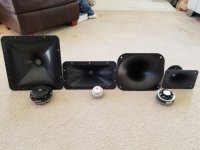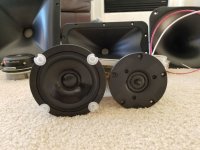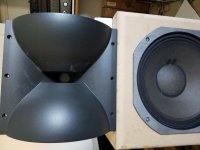Can you explain why please? It's quite likely I'm not understanding all of what Toole says, but I get the impression that isn't his conclusion, ie they aren't too much of an issue precisely because they are so early?Early reflections are not always bad. But in the context of small rooms for stereo listening, they *usually* are.
In my room I easily got almost 20 dB of clean impulse, and a residual sound field for a T60 around 0.4 s.
In the tiny room where I'm playing, this is hard to get. If I absorb, I go to a dry listening, with tonal distortion, if I keep reflections, I get a confused orchestra.
In the tiny room where I'm playing, this is hard to get. If I absorb, I go to a dry listening, with tonal distortion, if I keep reflections, I get a confused orchestra.
Hello,
There is a lot of focus on diffusion and absorption treatments and not so much conversation about directing the sound away from where you do not want it. If sound does not overspray into the room and reflect from surfaces you don’t want there will be much less perceived need for room treatment. There will be fewer first reflections masking or mudding direct sounds.
I have tried an assortment of different type drivers. The narrower the beamwidth the more well defined the sound stage is, there is a reduction in reflections and sense of space. There is a tradeoff, soundstage opposed to sense of space.
As the beamwidth widens the sound stage is less well defined. There is increased sense of space.
All this happens before we even start thinking treatments. You may not be able to place enough treatments in your small room using wide beamwidth speakers that over spray all around into the room.
See the attached photos; 100 X100 degree JBL H 1010HF-1’s, JBL PT 90 X 50 degrees, EighteenSound 80 X 60’s and FatialPro 60 X 40’s. The next photo is a Sonus Faber 5in mid bass and Scan Speak 1in tweeter. The last photo is old school Dolly Parton 100 X 100 with JBL2425HS (threaded attachment to horn). Dolly is playing 3 Doors Down as I type this.
The 60 X 40 Fatial Pro has the most well defined sound stage. Both of the 100 x 100 JBL’s are most forgiving of where you sit, you can get up and move around without destroying the sound stage. The Sonus Faber 5in mid bass and Scan Speak 1in tweeter unevenly splash sound all around the room, they do not have the focus of the waveguides.
Thanks DT
There is a lot of focus on diffusion and absorption treatments and not so much conversation about directing the sound away from where you do not want it. If sound does not overspray into the room and reflect from surfaces you don’t want there will be much less perceived need for room treatment. There will be fewer first reflections masking or mudding direct sounds.
I have tried an assortment of different type drivers. The narrower the beamwidth the more well defined the sound stage is, there is a reduction in reflections and sense of space. There is a tradeoff, soundstage opposed to sense of space.
As the beamwidth widens the sound stage is less well defined. There is increased sense of space.
All this happens before we even start thinking treatments. You may not be able to place enough treatments in your small room using wide beamwidth speakers that over spray all around into the room.
See the attached photos; 100 X100 degree JBL H 1010HF-1’s, JBL PT 90 X 50 degrees, EighteenSound 80 X 60’s and FatialPro 60 X 40’s. The next photo is a Sonus Faber 5in mid bass and Scan Speak 1in tweeter. The last photo is old school Dolly Parton 100 X 100 with JBL2425HS (threaded attachment to horn). Dolly is playing 3 Doors Down as I type this.
The 60 X 40 Fatial Pro has the most well defined sound stage. Both of the 100 x 100 JBL’s are most forgiving of where you sit, you can get up and move around without destroying the sound stage. The Sonus Faber 5in mid bass and Scan Speak 1in tweeter unevenly splash sound all around the room, they do not have the focus of the waveguides.
Thanks DT
Attachments
Detection of reflections in typical rooms | Request PDF
Reflections are not bad all the time. Only if they are detremental, you need to dampen them.
Directivity index is not something that the science guy's have reached consensus about. We just have to be patient and accept were the chips fall.
My opinion: We need a standard. But it must be a standard that can be achieved by normal consumers. They are not willing to change their living room into a scifi movie decor. They just want reasonably good sound for a fair price.
So imo presission listening rooms, control rooms and mastering rooms should have the characteristics of avarage living rooms. If they don't, the sound engineers must guess how it will sound. That is not an optimal situation.
Reflections are not bad all the time. Only if they are detremental, you need to dampen them.
Directivity index is not something that the science guy's have reached consensus about. We just have to be patient and accept were the chips fall.
My opinion: We need a standard. But it must be a standard that can be achieved by normal consumers. They are not willing to change their living room into a scifi movie decor. They just want reasonably good sound for a fair price.
So imo presission listening rooms, control rooms and mastering rooms should have the characteristics of avarage living rooms. If they don't, the sound engineers must guess how it will sound. That is not an optimal situation.
....
This is the circle of confusion.
....
The term "Circle of Confusion" Belongs to Optics or Photography for more than 100 years.
Circle of confusion - Wikipedia
It is the Folks at Harman that are confused.
What I see and hear Harman doing is that they have 6 or 7 standard listening rooms around the globe. They have groups of standard trained listeners. They have standard Spinorama speaker testing including Directivity Index. Putting it all together the standard listeners will prefer standard speakers in a standard listening room. If all that happens they will put the speakers in a box and send them to market and the speakers will "sound good" in your standard living room.
Thanks DT
Pano +1
You've mentioned before that the term "circle of confusion" originates from photography. That doesn't mean it can't be applied somewhere else.
The scientific method will make sure that in the long run, the truth will be unraveled.
Can you point out where the publications of the scientists working at Harman are not following the scientific method?
The scientific method will make sure that in the long run, the truth will be unraveled.
Can you point out where the publications of the scientists working at Harman are not following the scientific method?
Not specifically to scientific method.
Developing the Spinorama tests including Directivity Index is rigorously technical.
Developing and documenting standard listening rooms (AES Paper published) is rigorously technical.
Developing a program to train listeners to do preference (ABX) testing is rigorously technical.
To do correlation statistics to put all the above together to predict listener preferences based on Spinorama tests alone is rigorously technical.
To get cutesy and obfuscate the term Circle of Confusion to point out that other manufactures have not been nearly so rigorously technical, it is only marketing.
My complaint about the use of the term Circle of Confusion is that it is not used correctly. It is used only to be cutesy. Harman read it somewhere and grabbed it without reference or footnote, not rigorous or technical.
Thanks DT
Developing the Spinorama tests including Directivity Index is rigorously technical.
Developing and documenting standard listening rooms (AES Paper published) is rigorously technical.
Developing a program to train listeners to do preference (ABX) testing is rigorously technical.
To do correlation statistics to put all the above together to predict listener preferences based on Spinorama tests alone is rigorously technical.
To get cutesy and obfuscate the term Circle of Confusion to point out that other manufactures have not been nearly so rigorously technical, it is only marketing.
My complaint about the use of the term Circle of Confusion is that it is not used correctly. It is used only to be cutesy. Harman read it somewhere and grabbed it without reference or footnote, not rigorous or technical.
Thanks DT
Last edited:
What specifically is not correct in your opinion about the circle of confusion as used by the scientists Olive and Toole? For reference, this is what we're talking about:Audio Musings by Sean Olive: Audio's Circle of Confusion
What specifically is not correct in your opinion about the circle of confusion as used by the scientists Olive and Toole? For reference, this is what we're talking about:Audio Musings by Sean Olive: Audio's Circle of Confusion
Harman holds themselves as the model of precision. They measure and standardize everything in the audio chain. They can reliability predict listener preference from speaker Spinorama tests. This is where scientists and technicians morph into marketing and sales guys. This is where they point to the other manufacturers and audio industry and say they completely lack all precession, they are in a “Circle of Confusion” (Think, Circular Logic fallacy.)
“Audio’s “Circle of Confusion” is a term coined by Floyd Toole [1] that describes the confusion that exists within the audio recording and reproduction chain due to the lack of a standardized, calibrated monitoring environment. Today, the circle of confusion remains the single largest obstacle in advancing the quality of audio recording and reproduction.”
On the other hand, Optics and Photography for over 100 years has used the term “Circle of Confusion” precisely and rigorously.
In a weak moment Floyd Toole put on his marketing and sales hat and borrowed the term “Circle of Confusion” from Optics and Photography.
Thanks DT
Strawman argumentation. The circle of confusion is about the lack of a standard in the recording industry. It's a fact, nothing more nothing less.Harman holds themselves as the model of precision. They measure and standardize everything in the audio chain. They can reliability predict listener preference from speaker Spinorama tests. This is where scientists and technicians morph into marketing and sales guys. This is where they point to the other manufacturers and audio industry and say they completely lack all precession, they are in a “Circle of Confusion” (Think, Circular Logic fallacy.)
Don't sound engineers work to a standard regards reverberation?
Professional studio's control room is usually a trapezoid shape to avoid the direct reflection from the side wall to hit the engineer's ears, and to reduce room mode. I have never seen a mastering studio room that is not a rectangle. My impression is mastering rooms are not too different from high end audiophile shop's listing room with heavy carpet, while mastering rooms are usually larger. I have seen a cloud is attached to the ceiling in both type of studios. I think it's reasonable to think that the direct reflection from the ceiling should be treated well.
Last edited:
- Status
- This old topic is closed. If you want to reopen this topic, contact a moderator using the "Report Post" button.
- Home
- General Interest
- Room Acoustics & Mods
- early reflection of sidewalls: absorption or not?


